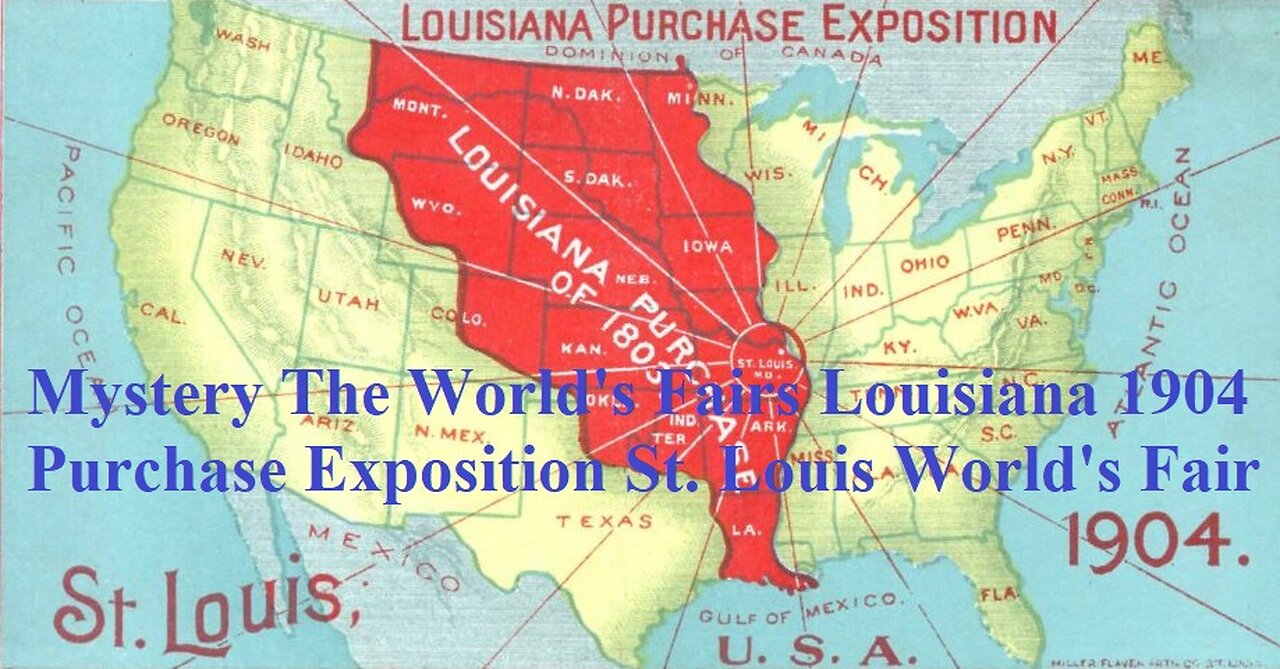Premium Only Content

Mystery The World's Fairs Louisiana 1904 Purchase Exposition St. Louis World's Fair
Mystery The World's Fairs Maybe the History we've been told is a lie! Were some ancient buildings built by a different race and their true history was covered up? Did ancient peoples have advanced forms of technology that have now been forgotten ? Was the massive kingdom of Tartaria visible on ancient maps much more advanced than we realize? This sub is an open forum for collaborative discussion of all topics "Tartaria" related, including Mud Flood, Tesla, AntiquiTech, Free Energy, Conspiracies, Hidden History, etc.
I wonder if this video has been posted here before? If yes, then i am not sorry for posting it again, because its just one helluva epic video. If not, I highly recommend watching it if you are interested in perhaps how Tartarian technology worked. I am still thinking about all the stuff he said and points out to us. As its a lot to deal with and can shake one up. I find it fascinating though.
Could it be that this civilization, split off from our official historical line of development, is behind many of the events of the 20th century?
And what of the World's Fairs? Were a large proportion of the World's Fair Buildings actually built from scratch, as the official historiography claims? There is much to suggest that the robber barons of the industrial age not only hid once widespread technological knowledge from us, but that they also hijacked some of the impressive architectural masterpieces in which parts of this knowledge was displayed.
Some of the buildings from the World's Fairs still exist today, and they are obviously not made of plaster or similar fragile materials. Were they subsequently rebuilt to be permanent structures? Is it even possible that the elaborately designed Expo sites were built with the technological capabilities of the time within just a few months, only to be destroyed again a few months later after the exhibitions had ended? Or is it plausible that after a great catastrophe the worldwide remains of the preceding high culture were not only systematically destroyed, but also pressed into an image of history imposed on us?
Some available information suggests that even after the worldwide, game-changing event we call the Reset or Mud Flood, there still remained countless complete and beautiful cities that were conquered by a new power elite and then repurposed as "World's Fairs".
Especially in America, the so-called New World, the many Greco-Roman cities would have been difficult to explain because in contrast to Europe, the Americas do not have an official greco-roman history.
The more carefully one investigates, the more difficult it becomes to find plausible explanations for the construction and destruction of these extraordinary and huge exhibition areas.
The official version about the World's Fairs can be summarized as follows: People in the 19th century loved Greco-Roman architecture for reasons unknown, so it was extremely important to the architects who organized the World's Fairs between 1850 and about 1914 to build in a classical style.
(Note: With World War I, classical architectural ambitions in Europe ended abruptly and many exhibitions also did not take place as planned. It was only in the wake of fascism that there was a return to ancient design principles, but these were often implemented superficially and were mainly applied to a few representative magnificent buildings. After the Second World War, on the other hand, classical architecture was deliberately replaced with new trends - e.g. Bauhaus and Brutalism. Officially the intention was to create an aesthetic distance to fascism, but in all likelihood its purpose was to cut the connection to the Old World through soulless, brutalistic architecture.)
No effort was spared for the world's fairs, enormous amounts of work went into creating complex statues, ornaments, columns, parks, buildings, and even the world's largest organs. No expenses were spared in the making of these massive structures. Made of plaster and linen or hemp fibers, they were only intended to last for the duration of the Expo. However the attention to detail was so great that purely visually there seemed to be no difference between the Expo buildings and the classical splendor-buildings of antiquity. The purpose of the World's Fairs was to make the supposedly "new" technologies discovered during the Industrial Revolution palatable to the masses, to create new markets. In the end, most of the buildings were torn down, with only meadows or empty parks remaining.
Louisiana Purchase Exposition, 1904 The 1904 World’s Fair was known as the Louisiana Purchase Exposition, as it celebrated the 100th anniversary of the purchase of the territory of Louisiana on April 30, 1803 from France. The exposition stretched from Forest Park to the west of St. Louis over an area of 500 hectares, making it one of the largest World’s Fairs ever organized. The Exposition was opened on April 30, 1904, and had over 19,000,000 visitors before it closed on December 1, 1904. It was a truly international exposition with over 50 countries having a presence.
The “Pike” was a 2 Km section of the exposition that contained all the amusements, including an incubator baby exposition. The exhibit was patterned after Couney’s sideshows at the Omaha Trans-Mississippi Exposition of 1898 and the Buffalo Pan-American Exposition of 1901, but Martin Couney was not involved. Although Couney had applied for the concession, it was awarded to a promoter named Edward M. Bayliss, who was willing to give up a larger share of the receipts to the exposition’s organizing committee. Bayliss partnered with a physician named Joseph Hardy, who had no experience with incubators or premature infants. Bayliss did at least purchase Lion-type incubators for the exhibit, presumably from the Kny-Scherer. After an epidemic of diarrhea among the infants and many deaths, described as a “charnel house” by the Humane Society, management of the exhibit was turned over to pediatrician John Zahorsky, who later documented his experiences in a articles in the St. Louis Courier of Medicine.
According to an article on the “At the Fair” web site, the construction costs for the exhibit were 31,000 dollars (equivalent to $1,380,000 in 2023). The entrance fee was 25 cents for adults, and 15 cents for children. The exhibit had 24 incubators and 10 trained nurses. An average of 25 babies were on display, and four lecturers would inform the crowd about the workings of the incubators and various statistics related to the care of the babies. After viewing the babies, visitors could purchase a souvenir soap baby and have lunch at the incubator exhibit’s Cafe.
St. Louis at the turn of the 20th century was the fourth largest American city. It was the site for the second major world's fair held in America. St. Louis was the jumping off point for many of the wagon trains that brought Americans on to the Great Plains and the Pacific west--the lands obtained in the Louisiana Purchase (1803). The St. Louis World's Fair commemorated the centennial of the Louisiana Purchase. The planners missed 1803 because of delays in construction and preparing the exhibitions. The promoters called it the "The Greatest of Expositions". It was indeed larger than the Colombian Exposition or any of the Victorian-era world's fairs held in Europe. There were nearly 20 million visitors during the 7 months the Exposition was open. operated. About 60 countries and almost all of the states (there were only 45 at the time) participated. More than 60 countries maintained exhibition spaces at the fair. Historians today tend to focus on the themes of race and empire. The Fair had a major impact study of of architecture, art, anthropology, and history. These and hundreds of manufacturing companies presented a view of civilization, history, arts, and industry. One of the big hits were the Native Americans, including Geronimo. The preparation for the Exposition was the backdrop for one of the most beloved American movies--Judy Garland's "Meet me in St. Louis" (1944). The film was a needed escapist diversion from the horrors of World War II.
The Louisiana Purchase Exposition, commonly known as the Saint Louis World's Fair of 1904, was the last great international exposition before World War I. The fair, built on a 1,200 acre site, included hundreds of thousands of objects, people, animals, displays, and publications from 62 exhibiting countries and 43 of the 45 states. The setting of world records, such as the largest organ, and working displays of every important technological advance were significant design goals. The Fair was a combination of trade show, civic showpiece, and monument to culture, along with more than a tinge of American pride. The Fair showcased the grandiose ambition of the gilded age, forming a kind of collective tribute to the nineteenth century's international understanding of the furtherance of peace, prosperity, and progress. It's a grand snapshot in time of American and foreign societies as they wished to portray themselves.
The Louisiana Purchase Expo, also known as the St. Louis World's Fair, was twice the size of the Chicago Expo and consisted of more than 1,500 buildings (General view of the Louisiana Purchase Exposition at St. Louis, photographed from top of Festival Hall) connected by roads and trails over a length of 121 km. Only two buildings are said to have been solidly and permanently built, while all others were demolished immediately after the Expo. The whole thing was financed with more than 15 million US dollars, at a time when St. Louis was in economic distress and its citizens were plagued by corruption, poverty and disease. The planning of the Expo itself was also overshadowed by several cases of corruption.
The first $5 million was provided by the City of St. Louis through the sale of Municipal bonds. Another $5 million was raised through private donations from interested citizens and businesses throughout Missouri. The final $5 million came in the form of funds that were part of a congressional appropriation bill passed in late May 1900. In the end, the Expo made a loss of $8.5 million, the equivalent of more than $250 million today. But if there was no financial incentive for the Expo - what was the point?
The Missouri Exposition Pavilion, as the largest and most impressive building, was supposed to have been preserved for future generations, but it burned down barely two weeks before the end of the Expo, on November 18, 1904. As it was said, a reconstruction was therefore renounced.
The approximately 4.9 km2 fairgrounds used for the World's Fair were located on what is now Forest Park and the Washington University campus, and it was the largest fair area the world at that time. The total construction time was less than three years and the Palace of Agriculture alone took up a staggering 81,000 square feet. It was said to be impossible to get even a glimpse of everything in less than a week.
More than 19 million people are said to have visited the Expo at that time. Remarkable, considering that St. Louis had only half a million residents back then. One observer of the World's Fair noted at the time that the streets of St. Louis were full of life, more so than any other city in the North.
George Kessler was the architect of the Expo. But oddly enough, there is a "popular myth" that says Frederick Law Olmsted actually designed the fairgrounds.
There are hundreds of photos of the alleged construction process of the Expo. And of course, various buildings were indeed newly constructed for the Expo - especially the trashy structures that lack the classicist aesthetic. Existing structures also appear to have been outfitted with obviously primitive, tasteless decorations. However, the photographs purporting to show the construction process of the grand, impressive classical exhibition palaces may as well have been made during demolition.
The Louisiana Purchase Exposition, also known as the St. Louis World’s Fair was held in 1904 to commemorate the 100th anniversary of the purchase of the Louisiana Territory from Napoleon’s France. With this transaction, Thomas Jefferson doubled the size of the United States at the time, and for only $15 million, which is less than 3 cents per acre. This purchase is considered “second in importance to the nation’s development only to the American Revolution.” Jefferson, on the council of his Cabinet, had to accept that a Constitutional Amendment was not necessary for the purchase, and later quipped: “it is the case of a guardian, investing the money of his ward in purchasing an important adjacent territory and saying to him when of age, I did this for your good.” Parts of 15 states would be carved from the real estate gained.
A celebration of the centennial of this event was well-justified, and what better place than the central location of St. Louis—inside the boarder of the Louisiana Territory. Plans were so grand, that the fair had to be delayed a year until April, 1904 to allow construction and setup to be completed. The fair was built on a 1,200 acre site on which 1,500 buildings were installed, connected by 75 miles of roads and sidewalks. Fifteen major exhibition palaces boasted landscaping lagoons, gardens, fountains and sculptures on the exterior with sometimes thousands of exhibits inside. These all spewed in a fan-like pattern from the massive Festival Hall which featured the Cascade gardens that flowed into the Grand Basin. The fair’s concept was so large that it was impossible to give even a hurried glance at all of the exhibits and paraphernalia in less than a week. Exhibits were set up for about 50 foreign countries and 43 (of the then 45) states. In all, the expo was experienced by nearly 20 million people.
Visitors travelled from all over to bask in the bliss of all the joys the fair had to offer. From lush gardens and landscapes, to concerts, contests, and theaters. By the turn of the 20th century, America was already living in the future of agriculture. New research in cultivation, gas-powered tractors, and new machinery made food easier to produce, and more plentiful than ever. Those who set up food booths and dainty shops wanted to impress visitors with the latest and greatest art and newly concocted flavors. There were palaces of sweet corn, butter sculptures, and animals made from fruit. One vender, the Syrian Ernest Hamwi, introduced a crisp, waffle-like cone, or cornucopia, when the booth next door offering ice cream ran out of bowls. St. Louis residents will tell you this is where the ice cream cone was born, but a man in New York had already patented the idea a year earlier, in 1903. Regardless, the crowds were surrounded by hundreds of novel options, and they lined up in a flurry to try them all.
While traveling to the fair may have been perilous for some, the fair itself was quite a safe environment. Gas lights covered the fairgrounds, illuminating the streets. Gambling was hindered so that even the up-and-coming sport—Cuban Jai Alai—was banned to prevent bets being placed during competitions. Eric P. Newman, the great numismatist, historian and author wrote, “my mother was arrested for driving her 2-cylinder Rambler auto at 21 miles per hour in Forest Park.” Security was run by a division called the “Jefferson Guards” who consisted of war veterans from the Spanish and Philippine-American wars. Visitors could be arrested for walking on the grass or carrying lit cigars into the exhibit buildings (which were constructed of wood). A total of 1,160 lost children were delivered to The Model playground, where parents could pick them up. Additionally, Scotland Yard agents, present to protect the exhibit of Queen Victoria’s jubilee treasures, were headed by Sir John Kenneth Ferrier, who demonstrated a new crime solving technique: fingerprinting.
Souvenirs were plentiful, and allowed every visitor to take a memento home with them. They represent a rare peaceful time in American history and happy memories from the fair. These include decorative plates, photographs, fans, spoons, pins, jewelry, post cards, ribbons, awards, sewing boxes, trays, watches, and so much more. Many of the items sold at the fair are now traded and sold among antique enthusiasts. The helpful reference “1904, St. Louis World’s Fair Mementos and Memorabilia” by Robert L. Hendershott has been the standard for identifying, categorizing and valuing these items. The book also features medallic items NGC certifies, including tokens, medals, encased cents, elongated cents, fobs, plaques, and punch tags. A selection of these items are featured below.
The official medals were struck in the US Mint Exhibit on the fairgrounds. They were struck in silver, copper, bronze, and gilt, with a single medal struck in gold. The silver medals sold for $1, and later $1.25, while the bronze sold for 25 cents, and the gilt-bronze for 50 cents.
The Exhibit Award Medals, had unique shapes but common center designs. They were designed by Adolph A. Weinman and struck at the US Mint in Philadelphia. The awards were presented to the exhibiters, along with a diploma, rather than having engravings done on the medals themselves. The obverse of the medal depicts Columbia (on the left) with her arms spread wide holding the US flag. A youthful maiden at her side, representing the Louisiana Territory is divesting herself of the cloak of France, which is decorated with bees (the emblem of Napoleon). Behind them is a rising sun, marking the dawn of a new era.
Most of the medals were struck in bronze (with a number of these plated with gold or silver), but recipients could request their medal be struck in gold or silver at their own expense. Few opted for this, however, and these medals are extremely rare. The commemorative medal pictured below is from the Louise E. Eliasberg collection, and is the only known example in gold. It graded NGC MS 66, and will be offered in Heritage's January FUN auction. The bronze medals were antiqued, and the process left a silvery finish, that is very apparent on some specimens.
An important person at the fair distributing coins and medals was a man named Farran Zerbe. Zerbe was an early rare coin dealer and supporter of the American Numismatic Association, and earned a reputation among fellow coin enthusiasts as a huckster. His flamboyant personality and shameless self-promotion irritated many fellow numismatists who refused to take him seriously. He ferociously promoted the commemorative gold dollar coins featuring Jefferson and President McKinley by distributing anonymous articles about them, without revealing that he was appointed as the Mint’s Director of Exposition coin and medal sales. Despite poor sales at $2 each, and later $2.50 he then raised the price to $3 a piece, claiming they were nearly sold out. This was back when the idea of paying more than face value for a commemorative coin seemed ridiculous, even in the eyes of serious collectors.
Zerbe also ran an exhibit titled “Moneys of the World” through which he tried to bolster interest in collecting coins, the ANA and… his own reputation. Disputes would later surface between Zerbe and collectors who had loaned coins for his exhibit and didn’t receive them back. However, to his credit, Zerbe was also well-studied, and sought to share his vast knowledge of numismatics with fairgoers and spread enthusiasm for the hobby. He issued a medal advertising his prices paid for rare coins in fine condition, which make collectors gawk today. A 1794 $1 is listed at $100, and the famed 1804 $1 is listed at $1,500, while a 1794 50c was listed at only $3!
Impressively, the Louisiana Purchase Exposition was the only fair in the Victorian era that actually turned a profit. Today, only photographs, souvenirs and a few buildings remain from the event. The beautiful fountains and iconic Cascades were demolished. The 265-foot-high Farris Wheel and it’s 36 cars (which could hold 60 people each), was blown up with 200 pounds of dynamite. Its enormous 45-foot axel was supposedly buried beneath what is now a golf course in Forrest Park, and historians are still searching for it. Nearly all of the wooden buildings were taken down and salvaged, except for the Palace of Fine Arts in which became the Saint Louis Art Museum. A mile away, people can revel in the past glories through the extensive (and free) exhibit “1904 World’s Fair: Looking Back at Looking Forward” in the Missouri History Museum near Forest Park.
The fair left a legacy not of American ingenuity and economics as the previous fairs had, but educated the attendees about what had become American culture, comparing it with those around the globe. One source claims that the fair was so comprehensive, that if every culture of the world had somehow been destroyed in a moment, that they could have been reconstructed from the vast amount of materials and education at the fair. But the fair also highlighted the superiority of western and Anglo-Saxon civilization, through its presentations, exhibits and the 1904 Olympic games held there. And most of all, it demonstrated in a grand way, America’s progress over the century since the Louisiana purchase.
Purpose of the World Exhibitions
If it is true that many of the buildings at the World's Fairs already existed and were only renovated, then the destruction of these buildings is one of the largest cover-ups in recent history. Also, this would be further proof that pretty much all countries were already controlled by the cabal 100 years ago, and modern politics was intended from the beginning as a means to infiltrate and control cultures. The systematic destruction of knowledge and the theft of cultural goods and property by the church continued seamlessly with the advent of more contemporary nation states. With the help of a central monetary system imposed on us, state-legitimized robbery is still the main cause of the transfer of wealth and possessions into the hands of a few.
The misappropriation of majestic old-world building sites by the new post-colonial power elite happened at the same time as other events that all seem to be connected. Thus, from the mid-19th century onwards, not only were World's Fairs held in oversized and far too expensive buildings that were completely inappropriate for them, but at the same time the first psychiatric hospitals ("insane asylums") were being built. Just like the world exhibitions, these psychiatric hospitals were architecturally unsuitable for the defined purpose. Architecture always reflects the consciousness of the builders and is defined by its purpose. However, we would expect industrialists to build simply and economically, to use steel and concrete, and by no means to demolish their buildings immediately, but to try to generate income from land and buildings for as long as possible. But we see just the opposite - the buildings at the World's Fairs are detailed, ornate, aesthetic, and far too large and expensive for their purpose. They represent something completely different from the world we know. They represent ancient Rome, the classical ideals of the beautiful, the true, the good; the pursuit of the divine and perfection.
The World's Fairs connect two completely opposite eras (or cultures) that should have no points of contact at all - the world of the industrial robber barons and an old world that we can no longer remember, but in which the economic principles we know played no great role.
Greatest Story Ever Un-Told 10 Parts Set and This 1893 World Columbian Exposition In Chicago Is Really A 1,000 Years Old City From Past Antiquitech Tartarian Empire and the True Believers in the “Tartaria” conspiracy theory that 100s of old world fairs 1801 thru 1940 era are convinced that the elaborate temporary fairgrounds built for events like the Panama-Pacific International Exposition in San Francisco in 1915 and 100s of other city were really the ancient capital cities of a fictional empire !
"Expositions are the timekeepers of progress. They record the world's advancement. They stimulate the energy, enterprise, and intellect of the people; and quicken human genius. They go into the home. They broaden and brighten the daily life of the people. They open mighty storehouses of information to the student. Every exposition, great or small, has helped to some onward step." President William McKinley, speaking at the 1901 Pan-American Exposition in Buffalo, NY.
The 1893 World Columbian Exposition in Chicago inaugurated an age of great fairs and expositions in the United States whose influence is felt to this day. The Chicago Exposition and the similar events that followed in Buffalo, NY; St. Louis, MO; Seattle, WA, San Francisco, CA and New York, NY dramatized technology and the fine arts, and illuminated the era ahead, as industrialism took hold, immigration peaked, science moved ever forward, and a vibrant, multi-faceted American music culture grew throughout the country.
Though the 1876 Philadelphia Centennial Exposition in Philadelphia had been a great success, the Chicago Exposition took its immediate inspiration from the Exposition Universelle held in Paris in 1889. Like all previous world's fairs, the Paris exposition hosted music and other entertainment among its exhibits, but in greater variety and on a much larger scale. A major work, Esclarmonde, was commissioned from French composer Jules Massenet and was performed nightly. Music from all over the world was heard, including Javanese gamelan, which was to have a profound effect on composer Claude Debussy. Fairgoers could also hear indigenous music at the village nègre, where some 400 Africans from European colonies spent the duration of the fair demonstrating their culture and crafts. A similarly conceived Algerian Village was also an attraction.
The organizers of the Chicago Exposition would try to match or outdo the 1889 Exposition in every way. For awhile, they even thought of creating a structure taller than the Eiffel Tower built for the 1889 fair, and the tallest building in the world at the time. In the end, they settled for a spectacular city-within-a-city that sprawled over 600 acres and featured 65,000 exhibits. "The White City," so named for its many white buidlings that were made even brighter by the night-time illumination supplied by General Electric, captured the imagination of the country, and drew over 27 million paying customers during its run from May 1st to October 30th, 1893. Within its walls, fairgoers could marvel at the ever-multiplying technological wonders of the age, enjoy art exhibits, concerts and sports; listen to lectures on various topics, view short films in the world's first dedicated movie theater, or ride the original Ferris Wheel.
The basic human desires for community, stories (the more outrageous the better) and the need to feel like a protagonist in a wider struggle are what pulls us from moments of real social, economic and cultural dislocation into fabricated histories. Buildings and cities are made to grow old, to outlast people, and to be a testament to these cultural histories. They’re a yardstick for a culture’s ability to endure. When they’re not given the chance to do this, the contradiction can break something loose, and send people scavenging for cultural memory that feels ancient enough to anchor them in an uncertain now.
Sullivan aptly describes here the poisoned rebirth of pseudo-classicism in the 20th century - the attempt to imitate the old structures without having understood the architectural principles. We always see two fundamentally different types of architecture in the photos of the expos - on the one hand, the massive, classicist buildings, with uniform and harmonious proportions of the golden ratio. They do not differ in the slightest from the real European renaissance buildings, because in fact they come from the same era. On the other hand, we also see cheap-looking, actually temporary buildings made of plaster and other cheap materials, which do not originate from any known historical epoch and which were obviously built with the intention of tearing them down again as quickly as possible.
Many temporary structures were erected around the old buildings for the Expos - e.g. cheap pavilions, walls made of plaster and imitations of famous buildings, but after the Expos not only the temporary but also the old buildings were demolished.
Did the World's Fairs perhaps serve, among other things, as an instrument to give people a national identity after the unified culture had collapsed? The separation into nations seems artificial - the Slavs, for example, seem just like the Germans of Nordic origin and thus part of the same people. The term "Slav" originated from the pejorative term "sclavi", was put into the world by the Vatican and stood for the "pagan" tribes of Europe who did not want to submit to the monotheistic power apparatuses. After the successful infiltration of the German cultural area, only the pagan Eastern Europeans were referred to as "Slavs". In fact, most of the nations we know today were not founded until after 1850 - modern Egypt, for example, only in 1953, after the British conquest. Illyria, the homeland of the Illyrians, became the Balkans after annexation by France. Free Tartary became Uzbekistan, Persia became Iran in 1935, the Ottoman Empire became Turkey in 1923, and so on. The old words have a meaning - our whole past resonates in them. When these words are spoken, that alone establishes a real connection with the past. By losing these words, we also lose that connection, and with it, the connection to our ancestors. Meanwhile, our world is divided into various soulless administrative units, controlled by a small secret elite.
It was at the Expos that people first came into contact with the "new technologies" - telephones, railways, electric light (i.e. the light bulb), wireless communication, incubators, cars, photography, films. In addition, the supposed realities of life in the colonies were also frequently depicted (Africa, South America, etc.). The creation of the patent system played an important role in building the monopolies - because only with patents it was possible to own knowledge and thus technologies, and thus control people.
The foundation of the world we live in today was laid then during the time of the world expositions. The technological knowledge of the old world was selected: One part of the knowledge was kept secret, the other part was presented to the public. One of the most important criteria in this decision-making process was whether a technology could be controlled by a central authority. Any form of free energy must have been very dangerous to the forces that controlled the robber barons of the industrial age from the shadows. It is important to understand that these industrialists had not earned their wealth themselves - they were born into elite families and chosen to play a predetermined role.
Only since the dawn of the 20th century has the attitude prevailed that one must take something from others in order to be able to have something oneself. Competition took the place of cooperation. These two opposing world views - cooperation and competition - can be visualized as follows: With a circle and a pyramid.
The competition system is pyramidally organized. It involves an authoritarian chain of command that requires absolute obedience. At the level of the intelligence services, this system is represented by the "need-to-know" principle. Competitive thinking can only arise in a hierarchically organized society. In this society, energy flows from the masses at the base upward to the top of the pyramid, where it may even be absorbed or consumed by non-earthly entities. At the top seems to be what is named in mythological, religious and esoteric lore as Satan, Antichrist, Evil, or the Demiurge. At the base of the pyramid are people who feel powerless, basically slaves. Success in this system is defined by making it "to the top". This always implies that on the way up you oppress other people - take something away from them. The further up you go, the more powerful you feel. Energy is represented or symbolized by money in this system. The money system was built in such a way that, in the sense of the pyramidal system, it gradually directs people's life energy to the top of the pyramid. We can assume that this is also where the true reason for the existence of the fiat money system is hidden: to rob people of their life energy.
We already encounter the connection between parasitic, paranormal beings, the monetary system and the oppression of humanity in the work "Momo" by the author Michael Ende: men in grey, called time thieves, steal people's time. These interdimensional parasites convince the adults that they can save time by depositing it in a time savings bank. The adults believe the promises of the men in gray. In reality, the more they save, the less time they have - the time they save is lost to them. Life gradually becomes sterile and bleak. Buildings become standardized and all look the same, just like clothes. No one lives in the present anymore, no one has time for each other and life becomes hectic. Only the children recognize the cold, vicious nature of the gray men, as they are still in touch with their own aliveness. The adults fall prey to the idea of having to save time and so their lives become increasingly bleak and grey. But the Gray Men are gradually able to cast their spell over the children as well. Only Momo can resist the cold, psychopathic power of the Grey Men. Outside of space and time, she defeats the Men in Grey, frees the stolen time, and gives people back their vitality and the love in their hearts.
It's amazing, by the way, that in the novel Momo lives in an old, decaying Roman amphitheater surrounded by dreary, modern new buildings. Momo represents the connection to the old world. She represents life. When Momo defeats the men in gray, the last one says with relief, "Finally it's over!" Michael Ende realized that evil has no existence of its own. It is only a shadow, a black hole, the absence of something. Evil can only exist as long as there are people running away from themselves and their own aliveness. The parasites are our own creation. The destruction of the parasites is the triumph of man over his own contradictory nature and his dark side.
Power and powerlessness are in truth only two sides of the same coin, and also in karmic terms everything has its price. Every experience of power is always based on a corresponding experience of powerlessness, even if these experiences are separated on a temporal level. A good metaphor for the pyramidal system is a black hole that absorbs all light, consumes everything and releases nothing - it is a one-way street. That's why secret societies exist in the first place - in a pyramidal system, the relevant decisions have to be made in the shadows and no one is allowed to know the people making the decisions. The system is like a hydra, and we can only see some of their heads. Evil is always absorbing, consuming, calculating, inward looking. It closes itself to life, to exchange and to truth.
Possibly in the old world, on the other hand, people were integrated into a cycle. Everything was cyclical and in balance. People knew that they had nothing to lose by giving to others. In these communities, people lived for each other - on an energetic level, energy flowed freely between them without flowing outward. In these small, healthy communities there were no authoritarian hierarchies, no chains of command, no parasitic forces. Authorities evolved naturally, and people with natural authority were keen not to abuse their power, as this would have resulted in expulsion from the communities. The system, built on cooperation, includes multiple rings running concentrically outward. In the center is the "heart" - the wisest, most intelligent, most capable people in the community. Unlike the pyramidal system, these people do not hide, for they need not fear transparency. Even architecture reflected this concentric system. For example, in the round city of Baghdad, or Atlantis, which was supposedly built in rings. From the center or heart of the city, life moves outward in rings. The city wall separates the city from the outside world, creating a self-contained, living system. Goodness is outwardly radiant, giving, without ulterior motive and without expecting anything in return. It is its own cause, its own source, and has enormous radiance.
This is a chronological list of international or colonial world's fairs.
https://en.wikipedia.org/wiki/List_of_world's_fairs
All elaborate temporary fairgrounds built are removed after the fair is over.
Real Timeline Of Deception Part 0 Exploring Tartaria 1000 Years
Exploring Tartaria - Old World Secrets Revealed
https://rumble.com/v2u8ef4-real-timeline-of-deception-part-0-exploring-tartaria-1000-years-added-to-ou.html
Real Timeline Of Deception Part 1 Exploring Tartaria 1000 Years
The Timeline Deception - Part I - Exploring Tartaria
https://rumble.com/v2ua8sa-real-timeline-of-deception-part-1-exploring-tartaria-1000-years-added-to-ou.html
Real Timeline Of Deception Part 2 Exploring Tartaria 1000 Years
The Timeline Deception - Part II - Exploring Tartaria
https://rumble.com/v2ubf4w-real-timeline-of-deception-part-2-exploring-tartaria-1000-years-added-to-ou.html
Real Timeline Of Deception Part 3 Exploring Tartaria 1000 Years
The King of Tartaria - Exploring Tartaria
https://rumble.com/v2ueih6-real-timeline-of-deception-part-3-exploring-tartaria-1000-years-added-to-ou.html
Real Timeline Of Deception Part 4 Exploring Tartaria 1000 Years
The Saints - Relics, Reliquaries, & The First Resurrection
https://rumble.com/v2ugl92-real-timeline-of-deception-part-4-exploring-tartaria-1000-years-added-to-ou.html
Real Timeline Of Deception Part 5 Exploring Tartaria 1000 Years
The Saints - The Ruling Class - Exploring Tartaria
https://rumble.com/v2uij7w-real-timeline-of-deception-part-5-exploring-tartaria-1000-years-added-to-ou.html
Real Timeline Of Deception Part 6 Exploring Tartaria 1000 Years
From Atheism, Agnosticism, New Age, Protestantism, to Roman Catholicism
https://rumble.com/v2ujvr6-real-timeline-of-deception-part-6-exploring-tartaria-1000-years-added-to-ou.html
Real Timeline Of Deception Part 7 Exploring Tartaria 1000 Years
The Millennial Kingdom of God - Exploring Tartaria
https://rumble.com/v2uldss-real-timeline-of-deception-part-7-exploring-tartaria-1000-years-added-to-ou.html
Real Timeline Of Deception Part 8 Exploring Tartaria 1000 Years
Magic of the White City 1893 Chicago World's Fair
https://rumble.com/v2un20g-real-timeline-of-deception-part-8-exploring-tartaria-1000-years-added-to-ou.html
Real Timeline Of Deception Part 9 Exploring Tartaria 1000 Years
1000 Years Added To Our History & Dark Ages Never Existed
https://rumble.com/v2uo07i-real-timeline-of-deception-part-9-exploring-tartaria-1000-years-added-to-ou.html
Real Timeline Of Deception Part 10 Exploring Tartaria 1000 Years
Church History - Complete Documentary AD 33 to Present
https://rumble.com/v2uprfu-real-timeline-of-deception-part-10-exploring-tartaria-1000-years-added-to-o.html
Real Timeline Of Deception Part 11 Exploring Tartaria 1000 Years
Christmas Unveiled - Pied Piper - Templars Secret - Saturn's Workshop - Giants Stealing Children
https://rumble.com/v2urmd0-real-timeline-of-deception-part-11-exploring-tartaria-1000-years-added-to-o.html
Real Timeline Of Deception Part 12 Exploring Tartaria 1000 Years
Ancient Cloning Factories - Foundlings - Incubators - Test-Tube Babies
https://rumble.com/v2uu8ck-real-timeline-of-deception-part-12-exploring-tartaria-1000-years-added-to-o.html
Real Timeline Of Deception Part 13 Exploring Tartaria 1000 Years
Homunculus Unveiled - Jesus - Artificial Generation - Liber Vaccae - Lost Esoteric Secrets
Archaix Chronology Anunnaki Sumerian Gods Crystalinks Timelines 2040B.C. 2046A.D.
Archaix 2.0 Doomsday Chronology Five color charts with extensive Legend-chronology; exhibits 62 dates involving 300 events in linear timeline combining the Phoenix and Nemesis X Object appearances, the Mayan Long-Count baktuns and the Anunnaki NER 600 year periods, a history spanning over 74 centuries to May 2040 and November 2046.
The Lost History of Earth (Ewaranon) W0W - A Must See Video Lost Earth
Everything we were taught about the Earth, History, Science, Space, Energy and our Civilization was a lie. This mind blowing documentary will shift your perspective of the world monumentally.
The Secret Life of Symbols with Jordan Maxwell Knowledge of the Heavens, Life on Earth
Ancient Religions From Alpha To Stone Age To Omega To Modern Times To Infinity
This 11.5 Hrs. Full Documentary With Sound Is About Ancient Religions From Alpha To Stone Age To Omega To Modern Times To Infinity.
Everything we were taught about the Earth, History, Science, Space, Energy and our Civilization was a lie. This mind blowing documentary will shift your perspective of the world monumentally.
Proofs Earth Is Not A Spinning Ball What The Hell Happened 200 Times Collection
Proofs Earth Is Not A Spinning Ball When a photo of spherical Earth is pointed out to flat-earthers, they will dismiss it as CGI in the blink of an eye; even if they haven’t done any analysis at all. They do this because their belief in flat-Earth is not evidence-based, and any evidence contrary to their beliefs needs to be invalidated no matter how. They are so used to doing it, and sometimes they become confused by it themselves, to the point that they would take the slightest hint of digital manipulation of any picture of the Earth as evidence of the flat Earth.
Mystery The World's Fairs 00 This Evidence Hidden History Chronological All World’s Fair's - https://rumble.com/v49zfro-mystery-the-worlds-fairs-this-evidence-hidden-history-chronological-all-wor.html
Mystery The World's Fairs 01 London 1851 Crystal Palace Works Industry All Nations - https://rumble.com/v49xr6f-mystery-the-worlds-fairs-london-1851-crystal-palace-works-industry-all-nati.html
Mystery The World's Fairs 02 Paris 1855 World's Fair L'Exposition Universelle de Paris # 1 - https://rumble.com/v49wmff-mystery-the-worlds-fairs-paris-1855-worlds-fair-lexposition-universelle-de-.html
Mystery The World's Fairs 03 Paris 1867 World's Fair L'Exposition Universelle de Paris # 2 - https://rumble.com/v49vttt-mystery-the-worlds-fairs-paris-1867-worlds-fair-lexposition-universelle-de-.html
Mystery The World's Fairs 04 Philadelphia 1876 Fair Centennial International Exposition - https://rumble.com/v49us5z-mystery-the-worlds-fairs-philadelphia-1876-fair-centennial-international-ex.html
Mystery The World's Fairs 05 Paris 1878 World's Fair L'Exposition Universelle de Paris # 3 - https://rumble.com/v49soh6-mystery-the-worlds-fairs-paris-1878-worlds-fair-lexposition-universelle-de-.html
Mystery The World's Fairs 06 Paris 1889 World's Fair Exposition Universelle de Paris # 4 - https://rumble.com/v49pdu3-mystery-the-worlds-fairs-paris-1889-worlds-fair-exposition-universelle-de-p.html
Mystery The World's Fairs 07 Chicago 1893 World's Fair World's Columbian Exposition - https://rumble.com/v49ryc5-mystery-the-worlds-fairs-chicago-1893-worlds-fair-worlds-columbian-expositi.html
Mystery The World's Fairs 08 Lyon 1894 Fair L'Exposition Internationale et Coloniale - https://rumble.com/v49qjd3-mystery-the-worlds-fairs-lyon-1894-fair-lexposition-internationale-et-colon.html
Mystery The World's Fairs 09 Nashville Tennessee 1897 Centennial International Exposition - https://rumble.com/v49obhi-mystery-the-worlds-fairs-nashville-tennessee-1897-centennial-international-.html
Mystery The World's Fairs 10 Omaha 1898 Nebraska Trans-Mississippi Exposition Part 1 - https://rumble.com/v49kvne-mystery-the-worlds-fairs-omaha-1898-nebraska-trans-mississippi-exposition-p.html
Mystery The World's Fairs 11 Omaha 1898 Nebraska Trans-Mississippi Exposition Part 2 - https://rumble.com/v49ls22-mystery-the-worlds-fairs-omaha-1898-nebraska-trans-mississippi-exposition-p.html
Mystery The World's Fairs 12 Buffalo 1901 New York World's Fair Pan American Exposition - https://rumble.com/v49dg39-mystery-the-worlds-fairs-buffalo-1901-new-york-worlds-fair-pan-american-exp.html
Mystery The World's Fairs 13 St. Louis 1904 World's Fair Louisiana Purchase Exposition - https://rumble.com/v49h2n9-mystery-the-worlds-fairs-st.-louis-1904-worlds-fair-louisiana-purchase-expo.html
Mystery The World's Fairs 14 Louisiana 1904 Purchase Exposition St. Louis World's Fair - https://rumble.com/v49bv7t-mystery-the-worlds-fairs-louisiana-1904-purchase-exposition-st.-louis-world.html
Mystery The World's Fairs 15 Seattle 1909 World's Fair Alaska Yukon Pacific Exposition - https://rumble.com/v499353-mystery-the-worlds-fairs-seattle-1909-worlds-fair-alaska-yukon-pacific-expo.html
Mystery The World's Fairs 16 San Francisco 1915 Panama-Pacific International Exposition - https://rumble.com/v49aa13-mystery-the-worlds-fairs-san-francisco-1915-panama-pacific-international-ex.html
Mystery The World's Fairs 17 1962 Seattle Chronological All International World’s Fair's - https://rumble.com/v49is0f-mystery-the-worlds-fairs-1962-seattle-chronological-all-international-world.html
Antiquitech Tartarian Empire Old World's Fairs 18 Before The World's Fair 1851 Thru 1974 - https://rumble.com/v4968hi-antiquitech-tartarian-empire-old-worlds-fairs-before-the-worlds-fair-1851-t.html
Chicago Old Museum Tell About 1,000 Year 19 Old World History Of 1893 World's Fair - https://rumble.com/v2cphwy-chicago-old-museum-tell-about-1000-year-old-world-history-of-1893-worlds-fa.html
Chilaga Where Chicago Is Now On Map 20 of America and 1893 World’s Columbian Exposition - https://rumble.com/v2cqmdc-chilaga-where-chicago-is-now-on-map-of-america-and-1893-worlds-columbian-ex.html
Antiquitech Tartarian Empire Greatest Story 21 Ever Un-told Rewriting Recorded History - https://rumble.com/v36porm-antiquitech-tartarian-empire-greatest-story-ever-un-told-rewriting-recorded.html
Welcome To Our Channel 2.4 Million+ Views In 2023 & 596 Video's So Far This Year Alone - Thanks To Everyone Who Like Us... Good Or Bad You Are All Welcome To Share Any Video's We Post To Your Friends And Other's... Thanks !
-
 3:10
3:10
What If Everything You Were Taught Was A Lie?
8 days agoHow The Left Are Trying To Destroy Americans’ Dismal Views Nation’s Politics Today
3.27K6 -
 1:04:06
1:04:06
In The Litter Box w/ Jewels & Catturd
22 hours agoSUCK IT UP! | In the Litter Box w/ Jewels & Catturd – Ep. 691 – 11/14/2024
67.2K20 -
 10:13
10:13
Mike Tyson
4 hours ago $6.14 earnedThe Will Determines the Skill | BEHIND THE MIKE #007
36.1K8 -
 DVR
DVR
Savanah Hernandez
1 hour agoHUGE SHAKE UP: Deep State fearful as Trump appointees shock the nation
20.5K11 -
 1:02:33
1:02:33
The Officer Tatum
2 hours agoLIVE: Liberals MELT DOWN Over Trump and Biden Meeting, Al Sharpton EXPOSED
37.9K19 -
 6:41
6:41
Film Threat
2 hours agoSYDNEY SWEENEY SAYS FEMINISM IS FAKE | Film Threat News
13.8K6 -
 30:53
30:53
Chef Donny
3 hours agoWhipping Up The Best Thanksgiving Mashed Potatoes with Rudy Junda | Chef Donny @Pepsi Live Stream
29.4K6 -
 59:15
59:15
Matt Kim
15 hours agoQuestions You’re Not Allowed to Ask After Trump’s Win | Matt Kim #124
28K6 -
 1:14:19
1:14:19
Mally_Mouse
4 hours agoLet's Play!!
19.6K2 -
 15:30
15:30
Bussin' With The Boys
5 hours agoHARDY Tells All About The World Of Writing Music
27.4K1